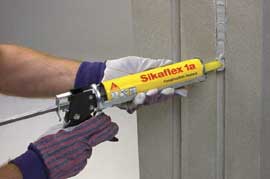The two most often used sealants on the market are polyurethane sealants, and silicone sealants. Each falls into the category of an elastomeric material and are used to fill gaps and keep water and air out. They also both allow for expansion and contraction, and can allow for up to 50 percent movement. Despite their similarities, these two kinds of sealants also have significant differences that make them each suitable for different types of applications. Here’s a closer look at both silicone sealants, and polyurethane sealants.
The chemical level
As their names suggest, polyurethane and silicone sealants are drastically different chemically. This difference means each material will break down differently over time, and react differently in different environments. Polyurethane is an organic material, while silicone is inorganic. That’s important because when subjected to UV light from the sun, inorganic materials will be less reactive than organic materials. Over time, the polyurethane sealant will revert to its natural state and change properties, which will render it ineffective for sealing the area.
Lifespan
As you may have guessed, the chemical differences make the lifespan of each sealant quite different. Typically, you can expect a polyurethane sealant to last 5 to 10 years, and the exact lifespan will depend on how much sunlight it was subjected to, the changes in temperature, and how often it needed to expand and contract. Silicone sealants will typically last at least 20 years, and many manufacturers even offer 20 year warranties to protect you in case your sealant wears out faster.
Cost
While silicone sealants typically about twice as long as polyurethane sealants, they also typically cost about twice as much. However, the initial cost of materials isn’t the only consideration to make when calculating the true cost. You’ll also want to factor in labor costs. Each type of sealant takes about the same amount of time to install, but you’ll need to install polyurethane sealants at least one additional time before the silicone sealant wears out. So, in reality, labor cost for polyurethane sealants is at least double that of silicone sealants.
Changing between polyurethane and silicone
If you have already applied a polyurethane sealant, or have inherited a structure with polyurethane sealant, and want to transition to silicone sealant, you’ll first need to ensure that all existing polyurethane material is completely removed. If part of the polyurethane sealant remains when you apply the silicone sealant, it can cause the new sealant to deteriorate faster than normal and destroy the seal. In most cases, it costs much more to replace a failed sealant than it would to install an effective one in the first place, so take your time to do the job right.
Whatever your need for sealants, Maxwell Supply in Tulsa has the right product for the job. Come see us, give us a call, or shop our inventory online.
